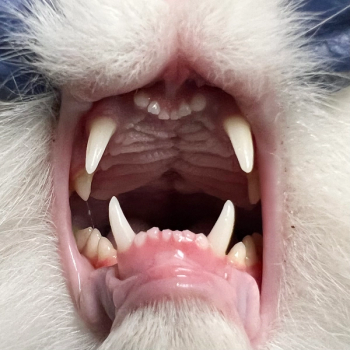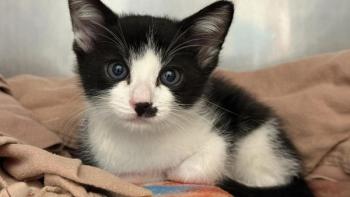
Degenerative joint disease in the cat (Proceedings)
Joint diseases can be classified into inflammatory or non-inflammatory.
Joint diseases can be classified into inflammatory or non-inflammatory. This allows us to further divide them into subcategories so that we can rule out some diseases and potentially reach an often difficult to obtain diagnosis. Non-inflammatory joint disease is often subdivided into either primary or secondary osteoarthritis. Primary osteoarthritis is usually referred to diseases of joint incongruity, dysplasia or osteochondritis dissecans. Traumatic or neoplastic diseases with joint involvement are referred to as secondary osteoarthritis.
Inflammatory joint disease is classified as either infectious or non-infectious. Non-infectious joint diseases occur secondary to an immune-mediated process that may be related to disease in another organ but do not involve an infectious agent at the joint itself. The immune mediated joint diseases are then subdivided into erosive or non-erosive based on the findings of survey radiographs.
Osteoarthritis (OA) or Degenerative Joint Disease (DJD)
Osteoarthritis is a slowly progressive disease characterized by joint pain, cartilage degeneration, and osteophyte production. It is most frequently caused by repeated micro trauma to articular surfaces. There is very little inflammation of the synovial lining and therefore few changes in the synovial fluid. The process is degenerative, not inflammatory.
Production of joint fluid and articular cartilage is altered in OA which results in decreased viscosity of the joint fluid, trauma to the articular cartilage, and finally to micro fracture to the subchondral bone. Trauma, from any cause including joint incongruity or osteochondritis dissecans, results in loss of chondrocytes and proteoglycans in the cartilage and joint fluid. This loss results in decreased protection of the articular cartilage to the loading forces placed on it during weight bearing. Inflammation results from the trauma and further destroys any chondrocytes left. Production of the normal components of cartilage and joint fluid continue to decline. More force is transferred across the joint to the subchondral bone and results in micro fracture of the bone, osteophytes, subchondral bone sclerosis, and joint degeneration.
Incidence of DJD in Cats
The incidence of degenerative joint disease or non-inflammatory joint disease increases with increasing age of the cat but may not be identified readily by the owner. Clinical signs are often not overt lameness but more subtle changes in the cat's behavior that indicate discomfort in the affected joints. These signs can include weight-loss, depression, seeking seclusion behavior, aggressive behavior, abnormal elimination habits, poor grooming habits, reduction in the ability to jump, and a stiff gait. Interestingly, unlike dogs, cats with OA are not typically overweight. The incidence of DJD in younger cats is estimated to be 34% while in geriatric cats (15 years of age) the incidence increases to up to 90%. These values often include cats with radiographic signs of OA but without clinical signs and the incidence of clinical signs of joint pain with concurrent radiographic changes in the same joint is about 33%. A sex predilection has not been definitively proven. Secondary OA is most commonly the result of trauma either causing soft tissue injuries to the supporting structures of the joint or fracture through the joint surfaces.
The most common joints affected either clinically or radiographically are the elbow and hip joints. Many cats have elbow osteophytes without clinical signs and no pain on manipulation of the joint especially if they are younger, however, as the osteoarthritis progresses, the joint disease can progress and lameness develops. 17% of geriatric cats have severe degenerative changes in their elbows on radiographs. The etiology of the joint disease in elbows of cats is unknown. Most cats are affected bilaterally. Some have speculated that joint incongruency is involved and fragmented medial coronoid processes have been reported in one cat. Hip dysplasia has been identified in cats and can be a cause of joint pain, however, many cats have degenerative changes in their coxofemoral joints on radiographs without signs of discomfort or lameness. Shoulder osteoarthritis occurs less frequently in cats than dogs. As with the coxofemoral joint, many cats may have radiographic degenerative changes but no pain upon examination of the joint.
Treatment of OA may be either conservative or surgical. Conservative treatment aims to control pain associated with the joint degeneration and to slow the progression of osteoarthritis. Weight control is an important consideration for cats with OA. Pain can be alleviated and their activity can increase if they are average to slightly under-weight. This is because increased body weight places greater force on the arthritic joint and increases damage to the articular cartilage and subchondral bone. Activity and movement of joints increases lubrication to the joint as well as nutrition to articular cartilage. In addition, muscle development can provide support to a joint to decrease instability secondary to chronic ligamentous injuries. The activity should be on a flat surface while jumping up and down off of counters, etc should be discouraged. Strict activity restriction for the first month in acute cases of joint injury may be warranted so that inflammation may subside. An NSAID such as meloxicam can control pain and improve the quality of life for many cats. Unfortunately, no NSAID can slow the progression of osteoarthritis and approximately 18% of cats can develop gastrointestinal disturbances such as vomiting while taking meloxicam.
Surgical management of osteoarthritis depends upon the joint involved and the cause of the degeneration. In cats with elbow OA, arthroscopic removal of joint mice and debridement of medial coronoid defects can resolve the lameness, however, severe degenerative joint disease may not respond to this treatment or signs may recur as the OA progresses. Elbow dysplasia and fragmented medial coronoid process has not been described in cats, but the frequency of bilateral OA in the elbows of cats makes these or some other form of primary OA more likely.
Treatment of hip dysplasia has been either with conservative management or surgical intervention. Since many cats have radiographic evidence of coxofemoral OA but no clinical signs of pain or lameness, conservative management is recommended most often. Only very severe cases of clinically debilitating OA requires surgical intervention in the cat. A femoral head and neck ostectomy is the most often performed surgical salvage procedure. Capital femoral physeal fractures in cats can be managed with femoral head and neck ostectomy but many heal well with primary repair of the Salter Harris I fracture with divergent K-wires.
Treatment of patellar luxation in cats has been controversial. Subluxation of the patella is not an uncommon finding in healthy cats, however with patellar luxation grades greater than 2 out of 4, surgical intervention has been successful. Conservative management with cage rest and meloxicam is still recommended in these cases prior to attempting surgical repair since 47% of cases have excellent outcomes with this conservative treatment. Severe grade 4 out of 4 patellar luxations have a poor prognosis just as in dogs. Surgical correction may be attempted depending upon the degree of degenerative joint disease present and clinical signs noted.
Cranial cruciate ligament disease in cats is most often secondary to acute trauma. Most cats will return to normal function following conservative management. Weight loss in addition to strict cage rest for 6 weeks is recommended since many cats with CCL instability are overweight. It is unknown if conservative treatment prevents progression of osteoarthritis long term, or whether the cats develop lameness later in life. If pain and lameness persist following medical management then surgical repair with an extracapsular suture technique such as lateral retinacular imbrication is most often employed. In addition, if collateral ligament instability is present, it is repaired with a prosthetic ligament during the same surgical procedure. Activity restriction is recommended for 6 weeks following surgery.
Inflammatory joint disease is divided into 2 categories, either an infectious etiology or a non-infectious one. Infectious etiologies in cats include bacterial, mycoplasma (felis and gateae), borrellia bergdorferi, anaplasma (ehrlichia), fungal (cryptococcosis), and viral (calici virus, feline syncytia-forming virus). Inflammatory OA can be either erosive, productive, or both. Most cases present with a polyarthropathy and all joints must be examined closely. Synovial fluid analysis should be performed with any suspected polyarthropathy. Infectious causes may have intermittent signs but may also present with other systemic signs such as depression, fever, anorexia and vomiting. Mycoplasma arthritis has been treated successfully with doxycycline or enrofloxacin for 4 to 6 weeks. Lyme disease as a cause of arthritis has been rarely reported in cats but the recommended treatment is doxycycline for at least 4 weeks.
Non-infectious inflammatory joint disease (immune-mediated) in the cat is divided into two forms identified on radiographs: erosive and non-erosive. The non-erosive form has radiographic evidence of soft tissue swelling around the joint and decreased joint space may be evident but there are no bone changes, either in density or proliferation of new bone. The erosive form will have marked changes radiographically including bone destruction, lysis, osteopenia, osteophytes, enthesiophytes and subchondral bone sclerosis. The joint may even be subluxated.
Regardless of the definitive diagnosis, the clinical presentation for immune-mediated joint diseases are similar and include malaise, anorexia, lethargy, and varying degrees of lameness, stiff gait or inactivity. Multiple joints are usually involved although it may be difficult to determine which joints are inflamed and we often perform arthrocentesis and radiographs on multiple joints even if there are no clinical signs in a joint at presentation. A synovitis develops in multiple joints due to a type III hypersensitivity reaction. Underlying causes of non-erosive polyarthritis are numerous and include systemic lupus erythematosus, paraneoplastic syndromes and immune complex disease secondary to chronic inflammatory conditions such as inflammatory bowel disease. Erosive polyarthropathies have not been extensively studied in cats but do appear to be a separate entity to systemic lupus erythmatosis. The disease has an increased incidence in males and some cats are FelV positive. The underlying cause, especially in male cats may be feline syncytia-forming virus or rheumatoid arthritis. Erosion of the carpal joints is most common but deterioration of the tarsus, stifle and elbows may also occur.
Treatment of immune mediated arthropathies involves treating the underlying condition and, in the case of lupus and erosive arthritis, immunosuppression is often recommended. Traditionally, the mainstay of treatment was corticosteroids and the prognosis was poor. Recently a report of 12 cases of erosive arthritis were treated with leflunomide and methotrexate. 58% of the cases showed marked improvement. Most cats were able to tolerate the treatments well since they were given once a week and did not develop any serious side effects. These cats must be monitored closely for liver toxicity and secondary infections.
In conclusion, joint disease in cats has been historically under-diagnosed and should be considered as a differential for cats presenting with vague signs of behavior change and decreased activity. Full exploration for a definitive diagnosis is recommended since treatment may markedly improve the quality of life for many patients.
References
1. Godfrey DR. Osteoarthritis in cats: a retrospective radiological study. J Small Anim Pract 2005;46:425-429.
2. Clarke SP, Bennett D. Feline osteoarthritis: a prospective study of 28 cases. J Small Anim Pract 2006;47:439-445.
3. Clarke SP, Mellor D, Clements DN, et al. Prevalence of radiographic signs of degenerative joint disease in a hospital population of cats. Vet Rec 2005;157:793-799.
4. Hardie EM, Roe SC, Martin FR. Radiographic evidence of degenerative joint disease in geriatric cats: 100 cases (1994-1997). J Am Vet Med Assoc 2002;220:628-632.
5. Staiger BA, Beale BS. Use of arthroscopy for debridement of the elbow joint in cats. J Am Vet Med Assoc 2005;226:401-403, 376.
6. Langenbach A, Green P, Giger U, et al. Relationship between degenerative joint disease and hip joint laxity by use of distraction index and Norberg angle measurement in a group of cats. J Am Vet Med Assoc 1998;213:1439-1443.
7. Hardie EM. Management of osteoarthritis in cats. Vet Clin North Am Small Anim Pract 1997;27:945-953.
8. Fischer HR, Norton J, Kobluk CN, Reed AL, Rooks RL, Borostyankoi F. Surgical reduction and stabilization for repair of femoral capital physeal fractures in cats: 13 cases (1998-2002). J Am Vet Med Assoc 2004;224:1478-1482.
9. Loughin CA, Kerwin SC, Hosgood G, et al. Clinical signs and results of treatment in cats with patellar luxation: 42 cases (1992-2002). J Am Vet Med Assoc 2006;228:1370-1375.
10. Umphlet RC. Feline Stifle Disease. Vet Clin North Am Small Anim Pract 1993;23:897-913.
11. McLaughlin RM. Surgical diseases of the feline stifle joint. Vet Clin North Am Small Anim Pract 2002;32:963-982.
12. Magnarelli LA, Bushmich SL, JW IJ, Fikrig E. Seroprevalence of antibodies against Borrelia burgdorferi and Anaplasma phagocytophilum in cats. Am J Vet Res 2005;66:1895-1899.
13. Liehmann L, Degasperi B, Spergser J, Niebauer GW. Mycoplasma felis arthritis in two cats. J Small Anim Pract 2006;47:476-479.
14. Zeugswetter F, Hittmair KM, de Arespacochaga AG, Shibly S, Spergser J. Erosive polyarthritis associated with Mycoplasma gateae in a cat. J Feline Med Surg 2007;9:226-231.
15. Tisdall PL, Martin P, Malik R. Cryptic disease in a cat with painful and swollen hocks: an exercise in diagnostic reasoning and clinical decision-making. J Feline Med Surg 2007.
16. Appel MJG. Lyme disease in dogs and cats. Compend Contin Educ Prac Vet 1990;12:617-626.
17. Hanna FY. Disease modifying treatment for feline rheumatoid arthritis. Vet Comp Orthop Traumatol 2005;18:94-99.
18. Pedersen NC, Pool RR, O'Brien T. Feline chronic progressive polyarthritis. Am J Vet Res 1980;41:522-535.
Newsletter
From exam room tips to practice management insights, get trusted veterinary news delivered straight to your inbox—subscribe to dvm360.






